
My mind is still buzzing with beaver echoes from the dazzling conference. The above is a neat trick Brock introduced me to, called ‘Wordle‘. It analyzes text and produces word clouds based on frequency of use. The more a word shows up the bigger it gets. This is from the ‘our story’ section of the website. Isn’t it beautiful?
I would love to do as good a job as Alex Hiller did reporting as our foreign correspondent on the Lithuanian conference, but for much of the time I was too awestruck to take notes and too excited to write them down. I can’t tell you what it was like to be amongst brilliant minds who knew far more than me about beaver science and advocacy. Here’s a brief summary of some of the presentations I enjoyed the most. They are in order of appearance, because honestly if they were in order of preference, Sherri would probably be first the last and the middle. No offence.

Dennis Martinez started the conference with a discussion of TEK (Traditional Ecological Knowledge). He was very interested in the interface between science and TEK and how true environmental solutions blended the two. He talked about the fact that as science grew more about calculation and less about OBSERVATION everyone lost out. He had remarkable things to say about fire and water, and observed that one of the biggest mistakes the settlers made when they came to America is that they assumed the land was ‘naturally’ that way, and not carefully tended by native peoples.

Glynnis Hood has produced such remarkable research that she has become the go-to scientist on beavers. She teaches at the University of Alberta and presented research on a remarkable project documenting the way beaver habitat augments surface water and storage – even without dams. She showed a map of four isolated ponds that beavers eventually connected with a system of canals, increasing interactivity and flow between ponds. She and her researchers mapped the floor of those ponds and found that beavers dug and carved in the bottom, creating differing zones and augmenting biodiversity. In colder areas beavers dig holes in ponds so that when they come out of the lodge during a freeze they have room to get to the food cache. We were both thrilled to wonder what the bottom of ponds in temperate zones look like. It’s never been studied.
Yet.
Dr. Hood is so famous that I was afraid to talk to her at first. Then I had the weird good fortune to be stranded at the airport with her for 90 minutes waiting for the plane that didn’t take me. She told me that after the article on our website about her presentation in Lithuania she had wondered ‘who these martinez beavers’ were and what was the story. I made sure she left with a Worth A Dam hat, and plenty of gossip. Since she was interested in beaver canals I told her about the Popular Science article of beavers on Mars and sent it to her. I just got a note back that she loved the picture and will send her paper when its done.

Mary O’Brien has been on my beaver radar since the seminal article in High Country news a few years back. I was excited to find out she was coming and hoping for great things. I wasn’t disappointed when she presented a work in progress about identifying the economic value of beavers for things like water management and silt trapping. She apparently has decided to do a beaver festival in Utah next year and wanted lots of ideas for involving the community. She decided that she will come to our festival this summer and see for herself.

Sherri gets her own post, but for now I’ll just say that she is a powerful, compassionate, humble speaker with a truly awesome gift for taking a roomful of people intimately into her world of caring for beavers. I am quite certain that not a single person in that conference was unchanged by the experience. Myself included.
 The very best part of Mike Callahan‘s presentation was his pragmatic invitation for others to practice his craft. “Flow devices work and anyone can learn to use them” was his message, and his style was to sit down and answer questions with anyone at any time. His excellent images showed me things I had not understood before, and he generously promised that any attendee at the conference could receive a free copy of his DVD. I first wrote Mike on November 4th, 2007 when I was consumed with a great sense of panic. Meeting him after so many years was powerful in ways it will take me a while to process.
The very best part of Mike Callahan‘s presentation was his pragmatic invitation for others to practice his craft. “Flow devices work and anyone can learn to use them” was his message, and his style was to sit down and answer questions with anyone at any time. His excellent images showed me things I had not understood before, and he generously promised that any attendee at the conference could receive a free copy of his DVD. I first wrote Mike on November 4th, 2007 when I was consumed with a great sense of panic. Meeting him after so many years was powerful in ways it will take me a while to process.

Joe Cannon and Amanda Parish are the beaver division for the Lands Council and gave a delightful presentation on their beaver relocation and community education program. one idea I particularly enjoyed was the concept of the beaver picnic, where families gathered to learn about the animals, see the habitat and have some fun. Amanda also talked about a delicious children’s activity making ‘candy beaver dams’ using m&m’s, pretzel sticks and frosting to stick it all together.They had a long drive back to Washington but I’m so glad they came! Hopefully at least one of them will make it for the festival this year.
 Chris Vennom was the biologist for the Methow beaver project. This bit of genius ecology is using fish hatcheries to house beavers before reintroducing them at carefully selected sites. We swapped beaver stories for much of the conference, I loaned him my mac when his didn’t work, and he was kind enough to repay me with remarkable footage he had take of a beaver underwater in the raceway. Trust me, it’s nothing you’ll forget.
Chris Vennom was the biologist for the Methow beaver project. This bit of genius ecology is using fish hatcheries to house beavers before reintroducing them at carefully selected sites. We swapped beaver stories for much of the conference, I loaned him my mac when his didn’t work, and he was kind enough to repay me with remarkable footage he had take of a beaver underwater in the raceway. Trust me, it’s nothing you’ll forget.
 Of course I already knew Brock Dolman and had heard him speak before, but his presentation was truly dynamic. His basic idea is that as global warming escalates the effects in communities are going to be felt keenest in the watersheds. Your watershed was your ‘lifeboat’ that would either buffer you or exploit you and it was in your self-interest to take care of it. Brock referenced our historical prevalence study and provided this excellent graphic which he graciously sent me last night. He also introduced me to a couple from Marin whose land may become the site of the next huge beaver reintroduction study. Stay tuned.
Of course I already knew Brock Dolman and had heard him speak before, but his presentation was truly dynamic. His basic idea is that as global warming escalates the effects in communities are going to be felt keenest in the watersheds. Your watershed was your ‘lifeboat’ that would either buffer you or exploit you and it was in your self-interest to take care of it. Brock referenced our historical prevalence study and provided this excellent graphic which he graciously sent me last night. He also introduced me to a couple from Marin whose land may become the site of the next huge beaver reintroduction study. Stay tuned.
All this could never have been possible without the thoroughly gracious attention of Leonard and Lois Houston, who must have slept 5 hours in four days. They were the first at every event and the last to leave, provided countless introductions and made every single person feel like this particular conference was going to be especially better because they were there. There were a hundred details they saw to, and they rarely enjoyed the luxury of just sitting and listening to the wonders. It is their vision, wisdom and tenacity that made it all possible
A final mention for Stanley Petrowski, president of SURCP. He was the ’emcee’ for the entire event, and seemed inexplicably good at everything: ecology, technology and psychology. He introduced every speaker, kept things running on time and made sure the electronics were agreeable. He greeted me with such enthusiasm I felt like a rock star and any time he needs a vacation I am certain he can fill in for the finest cruise director in the Bahamas.
Okay, that’s it for now. Don’t think for a moment that I am giving these folks anywhere near the credit they deserve, but I hope this gives you a flavor of what I experienced. Unfortunately, Michael Pollock had an urgent situation and wasn’t able to attend, so I will have to look forward to meeting him. It will take an enormously long time for me to sort through everything, but in the meantime let me just say that on the way home I was stuck waiting for a shuttle with a man from the Georgia Railroads who said, sagely, “Beavers? Beavers aren’t a problem. They’re easy to take care of. You just shoot them.”
Toto, I don’t think we’re in Kansas anymore.




 Our friends Mary and Sherry at the newly-formed Sierra Wildlife Coalition have developed such a taste for saving beavers they installed their first-ever flow device in Truckee while there was still snow on the ground. This is the group who received our first -ever beaver management scholarship, and it looks like we couldn’t have chosen a better recipient! I received these last night:
Our friends Mary and Sherry at the newly-formed Sierra Wildlife Coalition have developed such a taste for saving beavers they installed their first-ever flow device in Truckee while there was still snow on the ground. This is the group who received our first -ever beaver management scholarship, and it looks like we couldn’t have chosen a better recipient! I received these last night: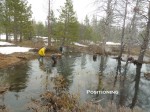
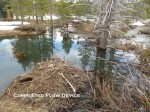

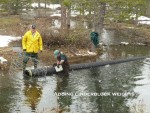
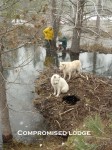
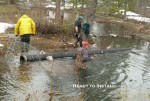
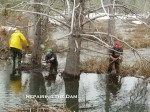
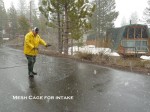
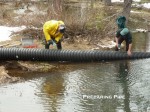






 The very best part of
The very best part of 








































